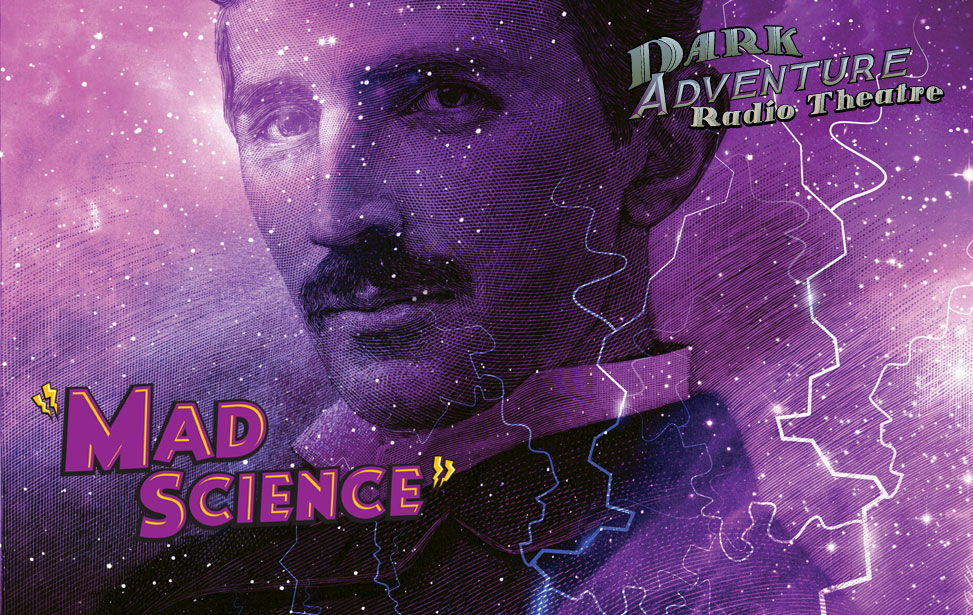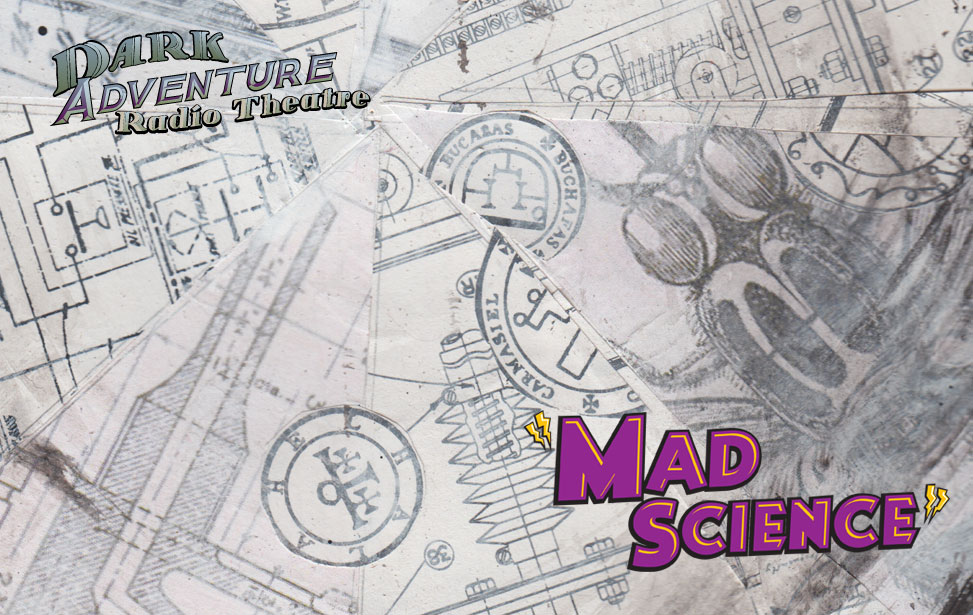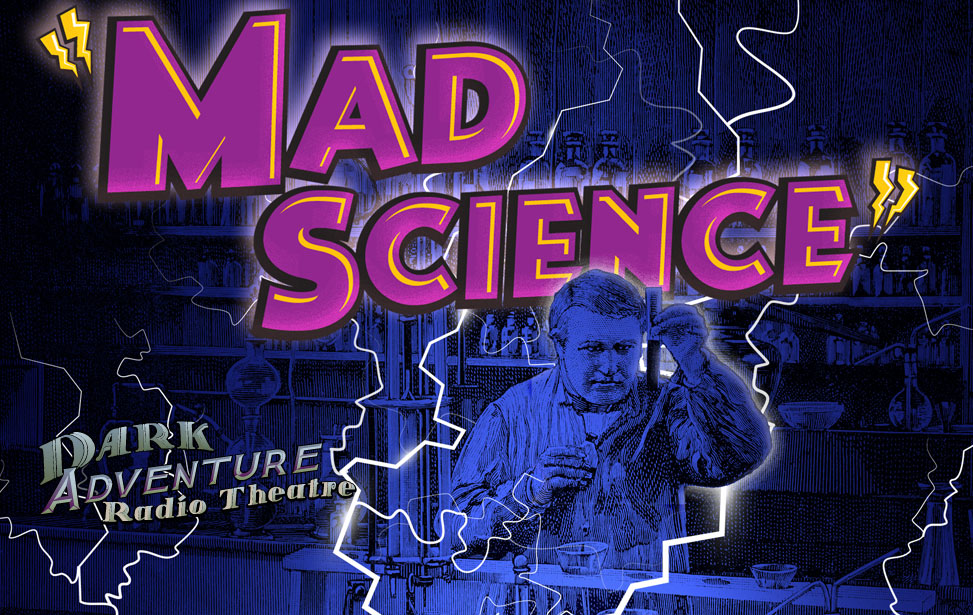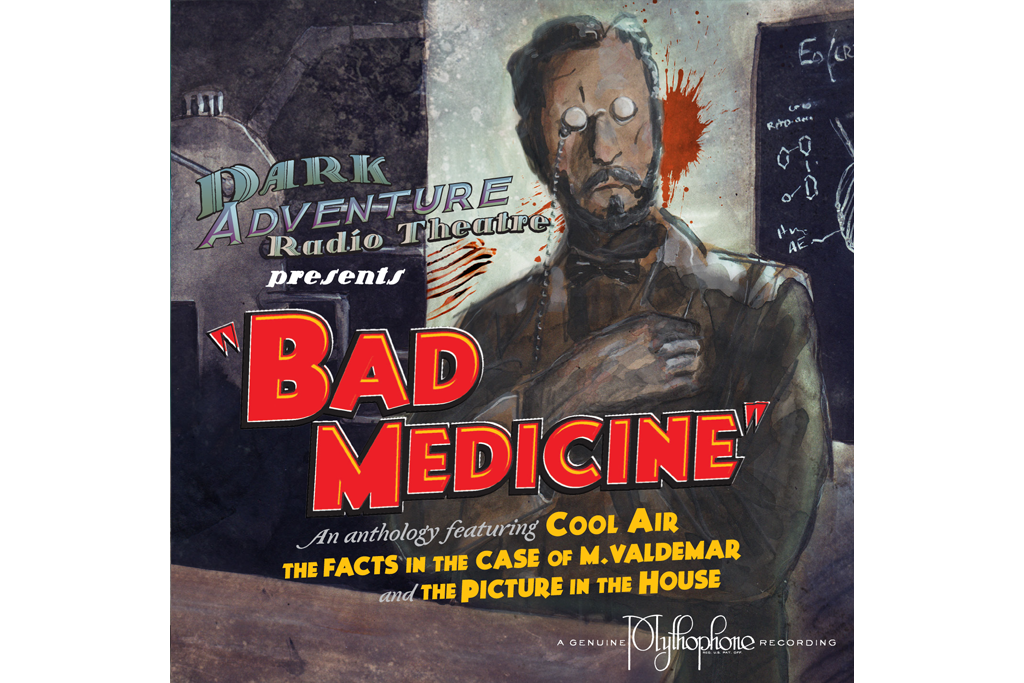Mad Science
"Rise and see what a genius of science hath wrought!"
Faust. Frankenstein. Moreau. Jekyll. Rotwang. The "mad scientist" has long been a beloved—and feared—character, and it's one that clearly appealed to H.P. Lovecraft. HPL loved science, and he knew all too well the frailty of the human mind. This special anthology episode brings together four tales of science at its strangest and most terrifying. Can a doctor penetrate the mysteries of a simple patient's bizarre and fantastical dream-life in "Beyond the Wall of Sleep"? Can an investigator survive a weird encounter with a deranged inventor in “The Electric Executioner”? Can a scheme of revenge be carried out through strange entomological means in “Winged Death”? And what horrors shall be revealed by a scientist's strange resonating machine in "From Beyond"?
Get it now!Props
To enhance your listening pleasure, the HPLHS has packed the binder sleeve for Mad Science with carefully created props from the story. You'll get:
Track Listing
1. Opening 3:32
2. Beyond the Wall of Sleep 19:43
3. The Electric Executioner 18:52
4. Winged Death 15:55
5. From Beyond 18:01
6. Closing 1:40
Total Runtime 77:43
Cast and Crew
Leslie Baldwin...Nurse Hunt, Juror #7
Sean Branney...Joe Slater, Arthur Feldon, Dr. Muñoz, Postal Clerk
Kacey Camp...Dr. Louise Pearce
Ken Clement...Lester Mayhew, Dr. Brainerd, Juror #9
Michael Feldman...Peter Slaader
Matt Foyer...Hugo, Theodore Waite
Andrew Leman...Smith, Mevana, Crawford Tillinghast
Luci Lyle...Dr. Talbot, Batta
Rosney Mauger...Enoch, Juror #4, Gobo
Johnny McKenna...Obediah, Harper, Juror #2, Walter McComb
William C. Stephens...Adunga, Dr. Okello
Kevin Stidham...Trooper Duclair, Slauenwite
Josh Thoemke...Announcer
Time Winters...Obando, Arnaud Bosch, Nikola Tesla
Based on "Beyond the Wall of Sleep" and "From Beyond" by H.P. Lovecraft
and "The Electric Executioner" by H.P. Lovecraft & Adolphe DeCastro
and "Winged Death" by H.P. Lovecraft & Hazel Heald
Written by Sean Branney & Andrew Leman
Original music by Reber Clark
Dark Adventure Theme by Troy Sterling Nies
Vocals recorded at Horse Latitudes Studio, Burbank, CA
Audio engineering by Shayna Adler and Michael Dumas
Cover and disc illustrations by Darrell Tutchton
Prop Inserts by Andrew Leman & Sean Branney
Spanish Translation by Hugo Ariel Zaccheo
Physics Consultant: Sue Hill
Produced by Sean Branney and Andrew Leman
Script, Liner Notes & More

In "Beyond the Wall of Sleep", Dr. Talbot theorizes about mental activity working like "ether waves." The story was written in 1919, and set in 1901, and at that time some scientists (and apparently Lovecraft) still thought that there was such a thing as the "luminiferous ether". Electromagnetic radiation (such as light and radio) seems to move in waves, so the "ether" was postulated to explain its ability to propagate through empty space, something that waves should not be able to do. Cutting-edge physicists questioned the existence of the ether as early as the mid-1800s, and the Michelson-Morley experiment (diagram shown above) and Einstein's theory of special relativity disproved it by 1905, but the general public continued to believe in—or at least refer to—the ether until the 1920s and beyond, perhaps because it was friendlier and easier to comprehend than Einstein's equations. For an interesting radio story about the ether, check out this episode of Science Friday.
 Lovecraft was fascinated by astronomy from his youth, and the "new star" that is featured at the end of "Beyond the Wall of Sleep" was a real nova that appeared in 1901, now known as GK Persei. The description Lovecraft quotes at the end of the story was from Astronomy with the Naked Eye, a book about astronomy for laypeople by Garrett P. Serviss. Serviss was the author of numerous books and newspaper columns to popularize science, as well as early science fiction. Lovecraft was a fan.
Lovecraft was fascinated by astronomy from his youth, and the "new star" that is featured at the end of "Beyond the Wall of Sleep" was a real nova that appeared in 1901, now known as GK Persei. The description Lovecraft quotes at the end of the story was from Astronomy with the Naked Eye, a book about astronomy for laypeople by Garrett P. Serviss. Serviss was the author of numerous books and newspaper columns to popularize science, as well as early science fiction. Lovecraft was a fan.
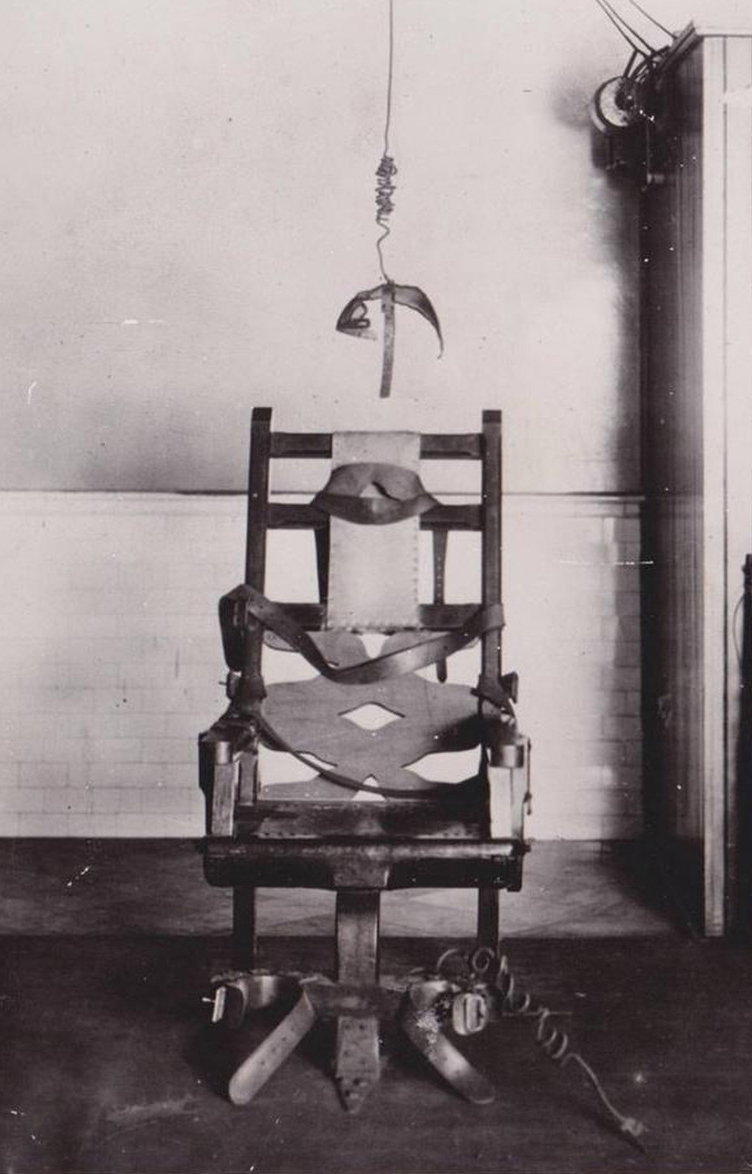
The first electric execution was carried out in New York in 1890: the condemned man was William Kemmler, who had axed his wife/girlfriend to death. The chair used to kill him (pictured at left) was invented by a Buffalo NY dentist named Alfred Southwick, after a series of botched hangings made people question the humaneness of execution in general. The chair was inspired by his dental chair.
As it happened, the development of the electric chair coincided with the "War of Currents" between the camps of Thomas Edison and Nikola Tesla, to see whose system of electricity would win out. The Edison company (which developed direct current (DC)) advocated for the use of Tesla's alternating current for the chair, to try to make sure that the public associated AC with death. Edison participated in the electrocutions of numerous dogs and horses in his attempt to defeat Tesla and Westinghouse.
Although electric execution was developed as a "humane" alternative to hanging, the execution of William Kemmler took about eight agonizing minutes. Witnesses said it was a horrible spectacle and it would have been better just to use an axe.
The bizarre contraption described in Lovecraft and DeCastro's story reminded us of Hugo Gernsback's Isolator, invented in 1925. Gernsback was an ardent science and technology buff who founded, among other things, Amazing Stories magazine and gave the science fiction genre its first home.

 When we chose to set the framing narrative for "The Electric Executioner" in a jury room, we had to ask ourselves if women were allowed to serve on juries in the 1920s. It turns out that the answer is a little complicated. Women only won the right to vote nationwide in 1920, but it did not automatically mean they won other rights of citizenship at the same time. They had to fight again for the right to serve on juries. It was argued that women were "too sensitive", would be "too sympathetic" or would be somehow sullied by hearing about crimes, and that their primary duty was in the home. Women were first allowed to sit on juries in California in 1917. It wasn't until 1975 that it became a right nationwide.
When we chose to set the framing narrative for "The Electric Executioner" in a jury room, we had to ask ourselves if women were allowed to serve on juries in the 1920s. It turns out that the answer is a little complicated. Women only won the right to vote nationwide in 1920, but it did not automatically mean they won other rights of citizenship at the same time. They had to fight again for the right to serve on juries. It was argued that women were "too sensitive", would be "too sympathetic" or would be somehow sullied by hearing about crimes, and that their primary duty was in the home. Women were first allowed to sit on juries in California in 1917. It wasn't until 1975 that it became a right nationwide.
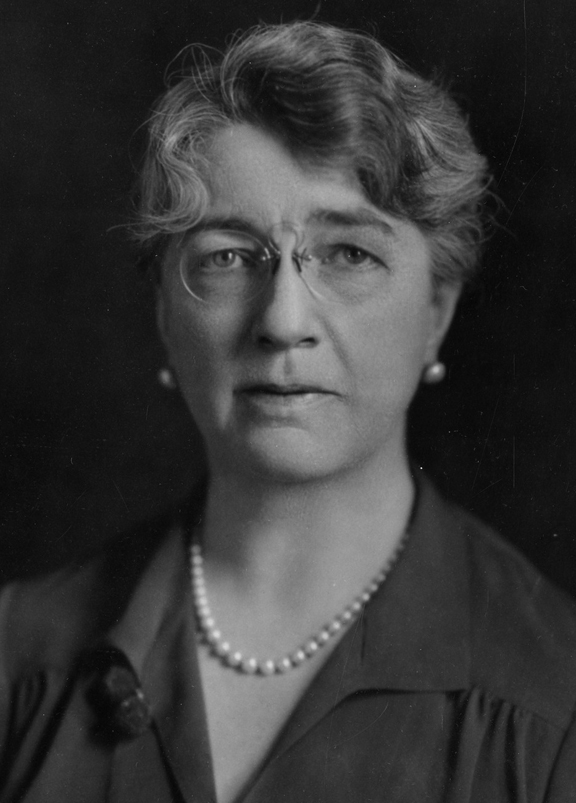 Two of the characters in our framing narrative for "Winged Death" are completely fictional, but Dr. Louise Pearce was a real medical specialist who developed cures for sleeping sickness in the Belgian Congo in the 1920s. We don't know if Lovecraft's co-author, Hazel Heald, knew of Dr. Pearce, but the many details in the story certainly suggest that she, or Lovecraft, did their homework on African diseases.
Two of the characters in our framing narrative for "Winged Death" are completely fictional, but Dr. Louise Pearce was a real medical specialist who developed cures for sleeping sickness in the Belgian Congo in the 1920s. We don't know if Lovecraft's co-author, Hazel Heald, knew of Dr. Pearce, but the many details in the story certainly suggest that she, or Lovecraft, did their homework on African diseases.
Below is a map from 1909 showing the distribution of tsetse flies and sleeping sickness in Africa. Click it to see a bigger version. We briefly considered making this map one of the bonus props for the episode. 

Tesla and Lovecraft have long been linked in fans' imaginations, with some believing he was an inspiration for the human avatar of Nyarlathotep. Nikola Tesla certainly fit the archetype of mad scientist, with his many genius contributions to technology in the late 19th and early 20th centuries, and we could not resist adding him to "From Beyond". If you don't already know about him, you should definitely start checking him out. And while you're at it, you should take a look at the science behind "From Beyond" at Fred Lubnow's Lovecraftian Science blog.
As we were working on this episode, we paid a visit to the Brown University Library website. We took a look at the typescript for "Beyond the Wall of Sleep" and were delighted and amazed to discover that it had all been typed on the backs of letters that Lovecraft received from other people. A picture of one of them is below. You can see the whole thing in amazing high-resolution scans at the Brown Digital Repository.


Science won wars, cured diseases, connected the planet and put humans on the moon. But in recent years it seems like science is increasingly marginalized, and madness is taking over. Mankind faces challenges that science can help us overcome, and science education is critically important for our future. HPLHS Founding Member Philip Bell is now a Professor of Learning Sciences at the University of Washington, and he is on the front lines of this very important fight. One of his many ongoing efforts is to develop science, technology, engineering and math teaching tools for educators across the country.
For your enjoyment, we present free PDF downloads of the final recording script and liner notes of "Mad Science". Note: this script is only for use for reading along with Dark Adventure Radio Theatre; no performance of the script may be made without written consent of the HPLHS.






